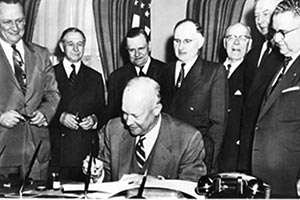Features Coordinator
Interstate System Turns 60; Highways Show Their Age

This story appears in the June 27 & July 4 print edition of Transport Topics.
The Interstate Highway System, the backbone of U.S. freight transportation, turns 60 years old this week.
The system, launched June 29, 1956, now weaves 46,876 miles of pavement throughout the nation, according to the Federal Highway Administration.
“The interstate system itself represents one of the greatest innovations in the nation’s history. A network of uniformly built roads connecting communities to each other makes us more than a nation — it makes our states united,” FHWA Administrator Gregory Nadeau said.
At its start, tractor-trailers traveled 28.8 billion miles in 1960. They traveled six times that much, or 169.8 billion miles, by 2014, the latest data provided by FHWA show.
Truck tonnage has increased by 231% since the interstate system began, according to American Trucking Associations. Of all of the domestic freight that moved last year, 70.1% crisscrossed interstates by truck, the federation said.
The longest section is Interstate 90 at 3,020 miles — stretching from Boston to Seattle, according to FHWA.
The shortest is Maryland’s I-97 at 17.62 miles, the agency said, and California, Texas and Florida highways are among the most heavily traveled.
Average daily truck traffic on I-90 in Seattle is 6,569 vehicles, according to Washington State Department of Transportation. Boston’s volume is 14,228 trucks per day, said Massachusetts DOT.
The short span on I-97 carries an average of 11,120 trucks per day, Maryland’s DOT said.
Plans for the nationwide road system were hatched in the late 1930s under President Franklin D. Roosevelt, with an initial vision of 26,700 miles of toll road. Fast forward to President Dwight Eisenhower, who signed the Federal-Aid Highway Act in 1956 and authorized $25 billion for the initial construction of 41,000 miles of interstate highways to be laid from 1957 to 1969.
“He had a good idea then, that had great ramifications in terms of our economy and our defense,” Sen. Jim Inhofe, (R-Okla.) said of Eisenhower.
“It has been a huge success, and I am glad I am a part of it,” added Inhofe, chairman of the Senate Environment and Public Works Committee, which oversees surface transportation policy. “If we hadn’t concentrated on doing what Eisenhower had started a long time ago, we would have serious problems in national defense.”
The first section of the interstate system was I-70, but whether Missouri or Kansas constructed it first is a long-running dispute. Missouri boasts of being the first state awarded a contract to construct a section of the interstate system, but Kansas argues it completed its segment first. The road, which runs through both states, extends from Maryland to Utah.
Almost all of the interstate system, more than 40,000 miles, was completed by 1980. The rest was added under recent legislation. Last year’s Fixing America’s Surface Transportation Act (written by Inhofe’s committee) ensures that more work will continue. Signed by President Obama on Dec. 4, the FAST Act authorizes $305 billion for road and bridge work as well as railroads. There are 58,495 structurally deficient bridges, according to the 2015 National Bridge Inventory.
Meanwhile, FHWA’s budget request for fiscal 2016 was $51.3 billion to maintain and improve the condition of the national highway system, DOT said.
“The challenge of age is not every piece is 60 years old, but parts are aging,” said Brian Pallasch of the American Society of Civil Engineers, whose organization graded America’s infrastructure D+ and estimates $3.6 trillion is needed by 2020.
Funding for the interstate system relies heavily on the 24.4 cents-per-gallon federal diesel tax and the 18.4 cents-per-gallon federal gasoline tax, which have not been raised since 1993.
Those who oppose increasing fuel taxes and those opposed to widespread tolling know that there is not enough funding to cover the costs of the interstate system, said Jeff Davis, a senior fellow at the Eno Center for Transportation. “Eventually, they will have to come to a reckoning with tolling.”
But tolls can be a significant cost for trucking, depending on region of operation, a 2015 analysis by the American Transportation Research Institute showed. Those operating in the Northeast had the highest average toll costs (4.4 cents per mile) while carriers in the West had the lowest (1.3 cents per mile).
Sen. Barbara Boxer (D-Calif.) questioned whether fuel-tax hikes are going to fix the problem.
“We need to look at other ways to figure out how to pay for the roads, such as vehicle miles traveled,” said Boxer who drives a plug-in hybrid car and barely has to purchase fuel. “I am not paying my fair share, so there must be a way to figure it out,” she said. “The gas tax is, and it should always be, there as a basic funding source. But I don’t think you’re going to see much appetite for raising it.”
That leaves legislation, such as the bold action taken 60 years ago.
“Dwight Eisenhower realized how important it was to be able to move products and people for our economy. He did the right thing with that system, and we have been pretty loyal,” Boxer said.

